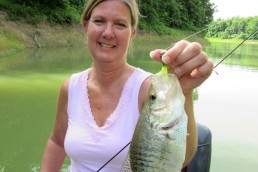Spring Fishing Tips from the Professionals
SHARE THIS POST
Five professional anglers who are members of the Bass Pro Shops National Fishing Team offered their advice on how to gain more enjoyment from the great sport of angling.
Here are some thoughts on family fishing from Edwin Evers, Bassmaster Elite Series Pro:
“One thing I love about fishing is that it tends to bring families together when everyone takes part. Husbands, wives and kids can all fish on even footing. Little Sister might just catch something bigger than Dad,” said Evers.
He believes spending time together and being on equal footing for that time yields very positive results. Nearly every family he has seen that begins fishing together assumes they will hate it, but then ends up wondering why they did not do it sooner.
“Even the most finicky female teenager is excited when hauling in a huge fish and posing in front of the camera with her catch. Frankly, more often than not, women tend to make better anglers than guys. By and large, this is because they tend to be more patient and don’t overwork their bait,” said Evers.
Want to get closer to your wife and kids? Take Evers’ advice and spend some quality time fishing with them.
Jimmy Houston, host of Jimmy Houston Outdoors, offered this advice for catching panfish:
“Worms, crickets and other live bait will nearly always catch panfish, but if you want to catch more fish, switch to jigs. Bug-like jigs rate as outstanding imitations, and tiny is better than big when it comes to picking the most effective jigs,” said Houston.
He believes mini-jigs should be fished at the sluggish pace that sunfish prefer, and the featherweight jigs snag less and will tempt fish that are not hungry enough to bite big bait. In addition, certain enticing retrieves are possible with tiny offerings that cannot be duplicated with larger ones.
“When panfish get picky, matching their diet with a jig imitation can definitely bring more action. Also, remember that they may smell the jig before deciding to eat, so using a panfish attractor or tipping it with a maggot or worm piece, could help. Panfish love bugs, and jigs that mimic these tiny creatures will help you pull in piles of panfish,” said Houston.
Pro angler and recent inductee to the Bass Fishing Hall of Fame, Stacy King, offered these tips to find pre-spawn largemouth bass:
“If you learn the hot spots where bass seek optimum habitat in which to deposit their eggs, you’ll catch more bass than the average angler. Back ends of creeks and coves are always good places to start and they are usually good when situated along northern banks that receive plenty of sun,” said King.
Are you enjoying this post?
You can be among the first to get the latest info on where to go, what to use and how to use it!
He looks for pea-gravel bottoms in creek arms and coves on the lower or deeper ends of reservoirs because bass love to spawn in those areas. King also knows spring rains often flood shoreline bushes that were high and dry during the winter drawdown, and that the firm bottom and protective cover in those areas attract spawning bass.
“If your favorite lake has lily pads, remember that they are not just great cover. Bass commonly spawn on the roots of the pads. Shallow flats and points that grow thick with aquatic vegetation can be good if there are open areas that bass can use for nesting sites,” advises King.
Kevin VanDam, Bassmaster Elite Series Pro, gives us this advice for post-spawn bass fishing.
“When bass are in shallow water during the post-spawn period, try a soft jerkbait (Bass Pro Shops Shadee Shad or Strike King’s KVD Perfect Plastics Caffeine Shads are examples). During this time, bass usually ignore other baits but they love this lure’s tantalizing action. They sink slowly which means you can put them right in front of a bass,” said VanDam.
He likes a soft jerkbait because it rides horizontally in the water instead of sinking nose down. Fish it on the surface or let it sink a little, then twitch it between pauses, causing the bait to dart upward like a wounded baitfish. Then, slowly settle.
“Six-inch baits are the most popular, but when they get really picky, go to smaller sizes. The best conditions to use them are clear water and calm weather,” claims VanDam.
Here is some advice for catching walleyes from Gary Parsons, Walleye Tour Pro:
“Spoons are sometimes overlooked as walleye baits, although they can be very effective—especially when fish are using weed beds in water 10 feet deep or shallower,” said Parsons.
When fishing areas like this, Parsons likes to cast a spoon as if he were fishing for bass, varying his retrieve, with pauses to let the spoon flutter down like a wounded baitfish. He advises attaching the spoon with a snap swivel for better flutter.
“Experiment with lure size and retrieve until you start catching fish. Then concentrate on consistency to “spoon feed” more walleyes on your next trip,” advises Parsons.
MWO
SHARE THIS POST
Did you enjoy this post?
You can be among the first to get the latest info on where to go, what to use and how to use it!
Darrell Taylor
Darrell Taylor has fished for more than 65 years. During the past 25 years, Taylor has generated more than 2,000 published articles, columns and fishing reports. His writings received 14 peer-level awards from outdoor writer organizations, including the Association of Great Lakes Outdoor Writers “Excellence in Craft” Golden Glow Award, their highest recognition.



